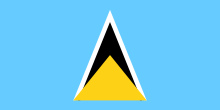ST LUCIA

St Lucia land’s area is 616 sq km. The centre of the island is very mountainous. The tallest point is Mont Gimie (950m), located in the south-west. In Soufrière town, the twin volcanic peaks overlook the Caribbean Sea and the rainforest : Little Peak (750m) and Big Peak (798m) which are listed as a UNESCO World Heritage Sites. In the region, there are also the famous Sulphur Springs. Despite of this volcanic activity, any volcano of the island erupted, since 1766.
St Lucia’s vegetation is varied : cacti and flowers like hibiscus and bougainvilleas grow in the dry zone while wild orchids, creepers and big trees (gum tree, châtaigner…) develop in rainy area. To protect this forest where many trees were cut during the colonization period a natural park has been founded.
The local wildlife is comprised of Saint Lucia parrot (Amazona Versicolor) called “Jacquot” which is the national emblem, the Saint Lucian loriot (a red bird), some snakes like the venomous “fer-de-lance” and the boa constrictor, the raccoon, the agouti, the hummingbird etc.
Banana, coconut and cocoa make up the main agricultural growings. Tourism is also an very important activity, in particular since the construction of hotels.
St Lucia was inhabited by the Arawak Indians between 1000 BC and 500 BC according to the archeological excavations. Around 800 AD, the Carib Indians massacred them and colonized the island.
Most probably, St Lucia was discovered by the Spanish explorers, in the early 1500s. In 1605, the Spanish colonists tried to settle in the island but the Carib warriors chased them out. After the previous attempt, in 1638, 400 British colonists tried again to occupy St Lucia but they left it, two years later ; most of them were killed by the Caribs.
When the English abandoned this land, the French seized St Lucia. In 1746, they founded Soufrière, the first town in the island and started to grow sugar cane. During several years, French and English fought to own St Lucia. In 1778, Great Britain won the war ; it built a naval base in Pigeon Island and Gros Islet, situated in the north of St Lucia, to go to conquer the other French possessions. During the following years, because of the rivalries and conflicts, St Lucia changed owners fourteen times. In the end, the island returned to Great Britain after the Treaty of Paris in 1814.
The British culture delayed to be accepted in St Lucia : English became official language in 1842 ; the parishes kept their French name ; 90% of the St Lucians are Catholics.
St Lucia became autonomous in 1967 then independent on February 22, 1979. The country is led by a Primer Minister and belongs to the Commonwealth. Like in the other ex British colonies in the Caribbean, the Head of State is Queen Elisabeth II of England, represented on the island by a governor general.
Area : 616 sq km (238 sq miles)
Population : 173 000 inhabitants
Capital : Castries
Languages : English (official) – Creole – Patois
Currency : Eastern Caribbean dollar (EC$)
People : St Lucians
